Nipple
| Nipple | |
|---|---|
 | |
| Details | |
| Part of | Breast |
| Identifiers | |
| Latin | papilla mammaria |
| MeSH | D009558 |
| TA98 | A16.0.02.004 |
| TA2 | 7105 |
| FMA | 67771 |
| Anatomical terminology | |
Thenippleis a raised region of tissue on the surface of thebreastfrom which, in females,milkleaves the breast through thelactiferous ductstobreastfeedan infant.[1][2]The milk can flow through the nipple passively or it can be ejected bysmoothmuscle contractionsthat occur along with the ductal system. Male mammals also have nipples but without the same level of function, and often surrounded bybody hair.
The nipple is surrounded by theareola,which is often a darker colour than the surrounding skin.[3]A nipple is often called ateatwhen referring to non-humans. "Nipple" or "teat" can also be used to describe the flexible mouthpiece of ababy bottle.In humans, the nipples of both males and females can besexually stimulatedas part ofsexual arousal.In many cultures, human female nipples aresexualized,[4]or regarded as sex objects and evaluated in terms of their physical characteristics and sex appeal.[5]Some cultures have little to no sexualization of the nipple, and goingtoplesspresents no barrier.[clarification needed]
Etymology
The word "nipple" most likely originates as adiminutiveofneb,anOld Englishword meaning "beak", "nose", or "face", and which is ofGermanic origin.[6]The words "teat" and "tit" share a Germanic ancestor. The second of the two, tit, was inherited directly from Proto-Germanic, while the first entered English viaOld French.[7][8]
Structure
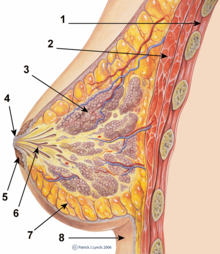
Inmammals,a nipple (also called mammary papilla orteat) is a small projection ofskincontaining the outlets for 15–20lactiferous ductsarranged cylindrically around the tip.Marsupialsandeutherian mammalstypically have an even number of nipples arranged bilaterally, from as few as 2 to as many as 19.[9]
The skin of the nipple is rich in a supply of specialnervesthat are sensitive to certain stimuli: these are slowly-adapting and rapidly-adaptingcutaneousmechanoreceptors.Mechanoreceptors are identified respectively by Type I slowly-adapting with multipleMerkel corpuscle end-organsand Type II slowly-adapting with singleRuffini corpuscle end-organs,as well as Type I rapidly-adapting with multipleMeissner corpuscle end-organsand Type II rapidly-adapting with singlePacinian corpuscle end-organs.The dominant nerve supply to the nipple comes from the lateral cutaneous branches of fourthintercostal nerve.[10]The nipple is also used as an anatomical landmark. It marks the T4 (fourth thoracic vertebra)dermatomeand rests over the approximate level of the diaphragm.[11]
The arterial supply to the nipple and breast originates from the anterior intercostal branches of the internal thoracic (mammary) arteries; lateral thoracic artery; and thoracodorsal arteries. The venous vessels parallel the arteries.[2]The lymphatic ducts that drain the nipple are the same for the breast.[2]The axillary nodes are the apical axillary nodes, the lateral group and the anterior group.[12]75% of the lymph is drained through the axillary lymph nodes located near the armpit. The rest of the drainage leaves the nipple and breast through infroclavicular, pectoral, or parasternal nodes.
Since nipples change throughout the life span in men and women, the anatomy of the nipple can change and this change may be expected and considered normal.[citation needed]
In male mammals
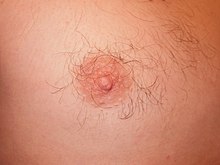
Almost allmammalshave nipples. Why males have nipples has been the subject of scientific research. Differences among the sexes (calledsexual dimorphism) within a given species are considered byevolutionary biologiststo be mostly the result ofsexual selection,directly or indirectly. There is a consensus that the male nipple exists because there is no particular advantage to males losing the trait. In consequence, some biologists would call the male nipple aspandrel.[13][14][15]
Function
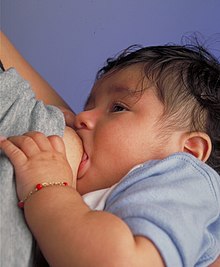
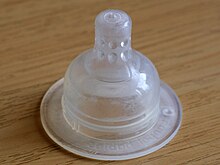
The physiological purpose of nipples is to delivermilk,produced in the femalemammary glandsduringlactation,to aninfant.During breastfeeding, nipple stimulation by an infant will stimulate the release ofoxytocinfrom thehypothalamus.Oxytocin is ahormonethat increases during pregnancy and acts on the breast to help produce themilk-ejection reflex.Oxytocin release from the nipple stimulation of the infant causes the uterus to contract even after childbirth.[16][17]The strong uterine contractions that are caused by the stimulation of the mother's nipples help the uterus contract to clamp down the uterine arteries. These contractions are necessary to preventpost-partum haemorrhage.[18]
When the infant suckles or stimulates the nipple, oxytocin levels rise and small muscles in the breast contract, moving the milk through the milk ducts. The result of nipple stimulation by the infant helps to move breast milk out through the ducts and to the nipple. This contraction of milk is called the "let-down reflex".[19]Latching on refers to the infant fastening onto the nipple to breastfeed. A good attachment is when the bottom of the areola (the area around the nipple) is in the infant's mouth and the nipple is drawn back inside his or her mouth. A poor latch results in insufficient nipple stimulation to create the let down reflex. The nipple is poorly stimulated when the baby latches on too close to the tip of the nipple. This poor attachment can cause sore andcracked nipplesand a reluctance of the mother to continue to breastfeed.[20][21]After birth, the milk supply increases based upon the continuous and increasing stimulation of the nipple by the infant. If the baby increases nursing time at the nipple, the mammary glands respond to this stimulation by increasing milk production.
Clinical significance
Pain
Nipple paincan be a disincentive for breastfeeding.[22]Sore nipples that progress to cracked nipples is of concern since many women ceasebreastfeeding due to the pain.In some instances, an ulcer will form on the nipple.[23]One reason for the development of cracked and sore nipples is the incorrect latching-on of the infant to the nipple. If a nipple appears to be wedge-shaped, white and flattened, this may indicate that the attachment of the infant is not good and there is a potential of developing cracked nipples.[24]Herpes infection of the nipple is painful.[25]Nipple pain can also be caused by excessivefrictionof clothing against the nipple that causes afissure.
Discharge
Nipple discharge refers to any fluid that seeps out of the nipple of the breast. Discharge from the nipple does not occur in lactating women. And discharge in non-pregnant women or women who are not breastfeeding may not cause concern. Men that have discharge from their nipples are not typical. Discharge from the nipples of men or boys may indicate a problem. Discharge from the nipples can appear without squeezing or may only be noticeable if the nipples are squeezed. One nipple can have discharge while the other does not. The discharge can be clear, green, bloody, brown or straw-coloured. The consistency can be thick, thin, sticky or watery.[26][27]
Some cases of nipple discharge will clear on their own without treatment. Nipple discharge is most often not cancer (benign), but rarely, it can be a sign of breast cancer. It is important to determine what is causing the discharge and to get treatment. Reasons for nipple discharge include:[26]
- Pregnancy
- Recent breastfeeding
- Rubbingon the area from a bra or T-shirt
- Injury to the breast
- Infection
- Inflammation andcloggingof the breast ducts
- Noncancerouspituitary tumors
- Smallgrowthin the breast (usually not cancer)
- Severe underactive thyroid gland (hypothyroidism)
- Fibrocystic breast(normal lumpiness in the breast)
- Use of certain medicines
- Use of certain herbs, such as anise and fennel
- Widening of the milk ducts[26]
Sometimes, babies can have nipple discharge. This is caused by hormones from the mother before birth. It usually goes away in two weeks. Cancers such asPaget's disease(a rare type of cancer involving the skin of the nipple) can also cause nipple discharge.[26]
Nipple discharge that is not normal is bloody, comes from only one nipple, or comes out on its own without squeezing or touching the nipple. Nipple discharge is more likely to be normal if it comes out of both nipples or happens when the nipples are squeezed. Squeezing the nipple to check for discharge can make it worse. Leaving the nipple alone may make the discharge stop.[26]
Nipple discharge in a male is usually of more concern. Most of the time a mammogram and an examination of the fluid is done. A biopsy is often performed. A fine needle aspiration (FNA) biopsy can be fast and least painful. A very thin, hollow needle and slight suction will be used to remove a small sample from under the nipple. Using a local anesthetic to numb the skin may not be necessary since a thin needle is used for the biopsy. Receiving an injection to prevent pain from the biopsy may be more painful than the biopsy itself.[28]
Some men develop a condition known asgynecomastia,in which the breast tissue under the nipple develops and grows. Discharge from the nipple can occur. The nipple may swell in some men possibly due to increased levels of estrogen.[29]
Appearance

Changes in appearance may be normal or related to disease.
- Inverted nipples– This is normal if the nipples have always been indented inward and can easily point out when touched. If the nipples are pointing in and this is new, this is an unexpected change.
- Skin puckering of the nipple – This can be caused by scar tissue from surgery or an infection. Often, scar tissue forms for no reason. Most of the time this issue does not need treatment. This is an unexpected change. This change can be of concern since puckering or retraction of the nipple can indicate an underlying change in breast tissue that may be cancerous.[30]
- The nipple is warm to the touch, red or painful – This can be an infection. It is rarely due to breast cancer.
- Scaly, flaking, or itchy nipple – This is most often due toeczemaor a bacterial or fungal infection. This change is not expected. Flaking, scaly, or itchy nipples can be a sign of Paget's disease.
- Thickened skin with large pores – This is calledpeau d'orangebecause the skin looks like an orange peel. An infection in the breast or inflammatory breast cancer can cause this problem. This is not an expected change.
- Retracted nipples – The nipple was raised above the surface but changes, begins to pull inward, and does not come out when stimulated.[31]
The average projection and size of human female nipples is slightly more than3⁄8inch (9.5 mm).[32]
Breast cancer
Symptoms ofbreast cancercan often be seen first by changes of the nipple and areola, although not all women have the same symptoms, and some people do not have any signs or symptoms at all. A person may find out they have breast cancer after a routinemammogram. Warning signs can include:[33][34]
- New lump in the nipple, or breast or armpit
- Thickening or swelling of part of the breast, areola, or nipple
- Irritation or dimpling of breast skin
- Redness or flaky skin in the nipple area or the breast
- Pulling in of the nipple or pain in the nipple area
- Nipple discharge other than breast milk, including blood
- Any change in the size or the shape of the breast or nipple
- Pain in any area of the breast[33][34]
Changes in the nipple are not necessarily symptoms or signs of breast cancer. Other conditions of the nipple can mimic the signs and symptoms of breast cancer.[33]
Vertical transmission
Some infections are transmitted through the nipple, especially if irritation or injury to the nipple has occurred. In these circumstances, the nipple itself can become infected withCandidathat is present in the mouth of the breastfeeding infant. The infant will transmit the infection to the mother. Most of the time, this infection is localized to the area of the nipple. In some cases, the infection can progress to become a full-blown case ofmastitisor breast infection.[35]In some cases, if the mother has an infection with no nipple cracks or ulcerations, it is still safe to breastfeed the infant.
Herpes infectionof the nipple can go unnoticed because the lesions are small but usually are quite painful. Herpes in the newborn is a serious and sometimes fatal infection.[25]Transmission of Hepatitis C and B to the infant can occur if the nipples are cracked.[36]
Other infections can be transmitted through a break of the skin of the nipple and can infect the infant.
Other disorders
- Nipple bleb
- Candida infectionof the nipple
- Eczema of the nipple
- Inverted nipple
- Staphylococcusinfection of the nipple
- Edematous areola[37]
- Herpes infectionof the nipple
- Reynaud phenomenon of the nipple[25]
- Flat nipple[38]
Surgery
Anipple-sparing/subcutaneous mastectomyis a surgical procedure where breast tissue is removed, but the nipple and areola are preserved. This procedure was historically done only prophylactically or with mastectomy for the benign disease over the fear of increased cancer development in retained areolar ductal tissue. Recent series suggest that it may be an oncologically sound procedure for tumours not in the subareolar position.[39][40][41]
Society and culture

Exposure
The cultural tendency to hide the female nipple under clothing has existed in Western culture since the 1800s.[4][5][42]As female nipples are often perceived anintimate part,covering them might have originated underVictorian moralityas with riding side saddle. Exposing the entire breast and nipple is a form of protest for some and a crime for others.[42][43]The exposure of nipples is usually consideredimmodestand in some instances is viewed aslewdorindecentbehavior.[44]
A case in Erie, Pennsylvania, concerning the exposure of breasts and nipple proceeded to theUnited States Supreme Court.[45]The Erie ordinance was regulating the nipple in public as an act that is committed when a person "knowingly or intentionally,... appears in a state of nudity commits Public Indecency." Later in the statute, nudity is further described as an uncovered female nipple. But nipple exposure of a man was not regulated. An opinion column credited toCecil Adamsnoted: "Ponder the significance of that. A man walks around bare-chested and the worst that happens is he won't get served in restaurants. But a woman who goes topless is legally in the same boat as if she'd had sex in public. That may seem crazy, but in the US it's a permissible law."[43]
The legality around the exposure of nipples is inconsistently regulated throughout the US. Some states do not allow the visualization of any part of the breast. Other jurisdictions prohibit any female chest anatomy by banning anatomical structures that lie below the top of the areola or nipple. Such is the case in West Virginia and Massachusetts. West Virginia's regulation is very specific and is not likely to be misinterpreted, stating: "[The] display of 'any portion of the cleavage of the human female breast exhibited by a dress, blouse, skirt, leotard, bathing suit, or other wearing apparel [is permitted] provided the areola is not exposed, in whole or in part.'"[43]
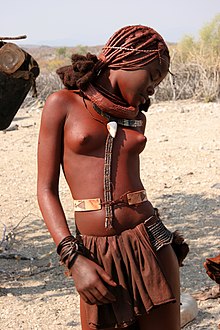
TheInstagramsocial media site has a "no nipples" policy with exceptions: material that is not allowed includes "some photos of female nipples, but photos of post-mastectomyscarring and women actively breastfeeding are allowed. Nudity in photos of paintings and sculptures is OK, too ".[46]Previously, Instagram had removed images of nursing mothers. Instagram removed images ofRihannaand had her account cancelled in 2014 when she posted selfies with nipples. This was incentive for the Twitter campaign#FreeTheNipple.[47][better source needed]In 2016, an Instagram page invited users to post images of nipples from both sexes; @genderless_nipples, which displays close ups of both the nipples of men and women for the purpose of spotlighting what may be inconsistency.[48]Some contributors have circumvented the policy.[49][50]Facebook has also been struggling to define its nipple policy.[48][51][52]
FilmmakerLina Escomade a film entitledFree the Nipple,which is about "laws against female toplessness or restrictions on images of female, but not male, nipples", which Esco states is an example ofsexismin society.[53]
Sexuality
Nipples can be sensitive to touch, andnipple stimulationcan incitesexual arousal.[54]Few women report experiencingorgasmfrom nipple stimulation.[55][56]Before Komisaruk et al.'sfunctional magnetic resonance(fMRI) research on nipple stimulation in 2011, reports of women achieving orgasm from nipple stimulation relied solely onanecdotal evidence.[57]Komisaruk's study was the first to map the female genitals onto the sensory portion of the brain; it indicates that sensation from the nipples travels to the same part of the brain as sensations from the vagina, clitoris and cervix, and that these reported orgasms are genital orgasms caused by nipple stimulation, and may be directly linked to the genital sensory cortex ( "the genital area of the brain" ).[57][58][59]
Piercings
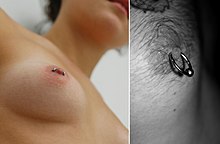
In business
Some companies and non-profit organisations have used the wordnippleor images of nipples to draw attention to their product or cause.[53][60]
See also
References
Citations
- ^"nipple".Retrieved4 August2017– via The Free Dictionary.
- ^abcHansen 2010,p. 80.
- ^"nipple".Taber's Online.Retrieved12 August2017.
- ^abBeer, Todd (2015-05-12)."Social Construction of the Body: The Nipple".SOCIOLOGYtoolbox. Archived fromthe originalon May 27, 2015.Retrieved2015-05-16.
- ^abDewar, Gwen (October 2012)."The sexualization of girls: Is the popular culture harming our kids?".Parenting Science.
- ^Harper, Douglas(2001–2010)."nipple".Online Etymological Dictionary.Retrieved15 August2011.
- ^Harper, Douglas(2001–2010)."teat".Online Etymological Dictionary.Retrieved15 August2011.
- ^Harper, Douglas(2001–2010)."tit (1)".Online Etymological Dictionary.Retrieved15 August2011.
- ^Ramel, Gordon."Mammalian Milk & Nutritional Profile of the Milk of Various Mammals".Earth Life.Retrieved2013-05-09.
- ^Grabb & Smith's Plastic Surgery 6th edition. Chapter 59 page 593
- ^Hansen 2010,p. 73.
- ^Imwold, Denise (2003).Anatomica's body atlas.San Diego, CA: Laurel Glen. pp. 286–7.ISBN9781571459237.
- ^Lawrence, Eleanor (5 August 1999)."Why do men have nipples?".Nature News.doi:10.1038/news990805-1.
- ^Burke, Anna (July 19, 2017)."Do Male Dogs Have Nipples?".American Kennel Club.
- ^Simons, Andrew M. (January 13, 2003)."Why do men have nipples?".Scientific American.
- ^Henry 2016,p. 117.
- ^"Glossary - womenshealth.gov".womenshealth.gov.2017-01-10.Retrieved12 August2017.
 This article incorporates text from this source, which is in thepublic domain.
This article incorporates text from this source, which is in thepublic domain.
- ^Abedi, P; Jahanfar, S; Namvar, F; Lee, J (27 January 2016)."Breastfeeding or nipple stimulation for reducing postpartum haemorrhage in the third stage of labour".The Cochrane Database of Systematic Reviews.1(1): CD010845.doi:10.1002/14651858.CD010845.pub2.PMC6718231.PMID26816300.
- ^"Guide to breastfeeding"(PDF).www.womenshealth.gov.Archived fromthe original(PDF)on 2020-10-17.Retrieved2017-08-12.
- ^"Breastfeeding checklist: How to get a good latch".WomensHealth.gov. 2017-06-09.Retrieved4 August2017.
 This article incorporates text from this source, which is in thepublic domain.
This article incorporates text from this source, which is in thepublic domain.
- ^"Common questions about breastfeeding and pain".womenshealth.gov. 2017-06-09.Retrieved4 August2017.
 This article incorporates text from this source, which is in thepublic domain.
This article incorporates text from this source, which is in thepublic domain.
- ^"WHO - Breastfeeding: Only 1 in 5 countries fully implement WHO's infant formula Code".www.who.int.Archived fromthe originalon August 6, 2013.Retrieved12 August2017.
- ^Santos, Kamila Juliana da Silva; Santana, Géssica Silva; Vieira, Tatiana de Oliveira; Santos, Carlos Antônio de Souza Teles; Giugliani, Elsa Regina Justo; Vieira, Graciete Oliveira (2016)."Prevalence and factors associated with cracked nipples in the first month postpartum".BMC Pregnancy and Childbirth.16(1): 209.doi:10.1186/s12884-016-0999-4.ISSN1471-2393.PMC4975913.PMID27496088.
- ^"Sore or cracked nipples when breastfeeding, Pregnancy and baby guide".www.nhs.uk.National Health Services (UK). 2017-12-21.Retrieved4 August2017.
- ^abcWalker 2011,p. 533.
- ^abcde"Nipple discharge: MedlinePlus Medical Encyclopedia".medlineplus.gov.Retrieved12 August2017.
 This article incorporates text from this source, which is in thepublic domain.
This article incorporates text from this source, which is in thepublic domain.
- ^"Nipple discharge".Mayo Clinic.Retrieved12 August2017.
- ^"How Is Breast Cancer in Men Diagnosed?".www.cancer.org.Retrieved12 August2017.
- ^Cuhaci, Neslihan; Polat, Sefika Burcak; Evranos, Berna; Ersoy, Reyhan; Cakir, Bekir (2014)."Gynecomastia: Clinical evaluation and management".Indian Journal of Endocrinology and Metabolism.18(2): 150–158.doi:10.4103/2230-8210.129104.ISSN2230-8210.PMC3987263.PMID24741509.
- ^Hansen 2010,p. 83.
- ^"Breast skin and nipple changes: MedlinePlus Medical Encyclopedia".medlineplus.gov.Retrieved12 August2017.
 This article incorporates text from this source, which is in thepublic domain.
This article incorporates text from this source, which is in thepublic domain.
- ^M. Hussain, L. Rynn, C. Riordan and P. J. Regan, "Nipple-areola reconstruction: outcome assessment";European Journal of Plastic Surgery,Vol. 26, Num. 7, December, 2003
- ^abc"Bring Your Brave Campaign - Symptoms of Breast Cancer".CDC.Retrieved12 August2017.
 This article incorporates text from this source, which is in thepublic domain.
This article incorporates text from this source, which is in thepublic domain.
- ^ab"Breast Cancer in Young Women".CDC.September 8, 2016. Archived fromthe originalon Sep 26, 2017.Retrieved12 August2017.
 This article incorporates text from this source, which is in thepublic domain.
This article incorporates text from this source, which is in thepublic domain.
- ^"National Anti-retroviral Therapy Guidelines"(PDF).World Health Organization.National Centre for AIDS & STD Control. 2009. Archived fromthe original(PDF)on 2020-05-25.Retrieved2020-10-05.
- ^"Breastfeeding vs. Formula Feeding".MedlinePlus Medical Encyclopedia.Retrieved12 August2017.
- ^Walker 2011,p. 524.
- ^Walker 2011,p. 530.
- ^Gerber B, Krause A, Reimer T, et al. (2003)."Skin-sparing mastectomy with conservation of the nipple-areola complex and autologous reconstruction is an oncologically safe procedure".Ann. Surg.238(1): 120–7.doi:10.1097/01.SLA.0000077922.38307.cd.PMC1422651.PMID12832974.
- ^Mokbel R, Mokbel K (2006). "Is it safe to preserve the nipple areola complex during skin-sparing mastectomy for breast cancer?".Int J Fertil Female's Med.51(5): 230–2.PMID17269590.
- ^Sacchini V, Pinotti JA, Barros AC, et al. (2006). "Nipple-sparing mastectomy for breast cancer and risk reduction: oncologic or technical problem?".J. Am. Coll. Surg.203(5): 704–14.doi:10.1016/j.jamcollsurg.2006.07.015.PMID17084333.
- ^ab"Toplessness - the one Victorian taboo that won't go away".BBC News.15 November 2014.Retrieved13 August2017.
- ^abc"Why Are Women Expected to Keep Their Nipples Covered?".14 February 2014.Retrieved13 August2017.
- ^D. Leder,The Body in Medical Thought and Practice,page 223, Springer Science & Business Media, 1992,ISBN978-0-7923-1657-2
- ^"Erie v. Pap's A. M., 529 U.S. 277 (2000)".Justia Law.Justia. March 2000.Retrieved15 February2018.
Nudity cannot be considered an inherent form of expression.
- ^"Community Guidelines".help.instagram.com.Instagram.Retrieved15 February2018.
- ^"Instagram Clarifies Its No-Nipple Policy".17 April 2015.Retrieved13 August2017.
- ^abToor, Amar (6 December 2016)."Genderless Nipples exposes Instagram's double standard on nudity".The Verge.Retrieved13 August2017.
- ^"Art student challenges 'sexist' ban on nipples on Instagram with new project - BBC Newsbeat".BBC News.6 June 2017.Retrieved14 August2017.
- ^Shire, Emily (9 September 2014)."Women, It's Time to Reclaim Our Breasts".The Daily Beast– via www.thedailybeast.com.
- ^"Community Standards".m.facebook.com.Retrieved14 August2017.
- ^"Is Facebook going to start freeing the nipple?".Fox News.24 October 2016.Retrieved14 August2017.
- ^abShire, Emily (9 September 2014)."Women, It's Time to Reclaim Our Breasts".The Daily Beast.
- ^Harvey, John H.; Wenzel, Amy; Sprecher, Susan (2004).The Handbook of Sexuality in Close Relationships.Psychology Press.p. 427.ISBN978-1135624705.RetrievedAugust 12,2017.
- ^Kinsey, Alfred C.; Pomeroy, Wardell B.; Martin, Clyde E.; Gebhard, Paul H. (1998).Sexual Behavior in the Human Female.Indiana University Press.p. 587.ISBN978-0253019240.RetrievedAugust 12,2017.
There are some females who appear to find no erotic satisfaction in having their breasts manipulated; perhaps half of them derive some distinct satisfaction, but not more than a very small percentage ever respond intensely enough to reach orgasm as a result of such stimulation (Chapter 5). [...] Records of females reaching orgasm from breast stimulation alone are rare.
- ^Boston Women's Health Book Collective (1996).The New Our Bodies, Ourselves: A Book by and for Women.Simon & Schuster.p. 575.ISBN978-0684823522.RetrievedAugust 12,2017.
A few women can even experience orgasm from breast stimulation alone.
- ^abMerril D. Smith (2014).Cultural Encyclopedia of the Breast.Rowman & Littlefield.p. 71.ISBN978-0759123328.RetrievedAugust 12,2017.
- ^Justin J. Lehmiller (2013).The Psychology of Human Sexuality.John Wiley & Sons.p. 120.ISBN978-1118351321.RetrievedAugust 12,2017.
- ^Komisaruk, B. R.;Wise, N.; Frangos, E.; Liu, W.-C.; Allen, K; Brody, S. (2011)."Women's Clitoris, Vagina, and Cervix Mapped on the Sensory Cortex: fMRI Evidence".The Journal of Sexual Medicine.8(10): 2822–30.doi:10.1111/j.1743-6109.2011.02388.x.PMC3186818.PMID21797981.
- Stephanie Pappas (August 5, 2011)."Surprise finding in response to nipple stimulation".CBS News.
- ^Disser, Nicole (19 August 2014)."This New Bushwick Bar Is The Most Literal Boobie Trap We've Ever Seen".Bedford and Bowery.
Bibliography
- Davidson, Michele (2014).Fast facts for the antepartum and postpartum nurse: a nursing orientation and care guide in a nutshell.New York, NY: Springer Publishing Company, LLC.ISBN978-0-8261-6887-0.
- Durham, Roberta (2014).Maternal-newborn nursing: the critical components of nursing care.Philadelphia: F.A. Davis Company.ISBN978-0803637047.
- Hansen, John (2010).Netter's clinical anatomy.Philadelphia: Saunders/Elsevier.ISBN9781437702729.
- Henry, Norma (2016).RN maternal newborn nursing: review module.Stilwell, KS: Assessment Technologies Institute.ISBN9781565335691.
- Lawrence, Ruth A.; Lawrence, Robert M. (13 October 2015).Breastfeeding: A Guide for the Medical Professional.Elsevier Health Sciences. pp. 227–8.ISBN978-0-323-39420-8.
- Walker, Marsha (2011).Breastfeeding management for the clinician: using the evidence.Sudbury, Mass: Jones and Bartlett Publishers.ISBN9780763766511.
